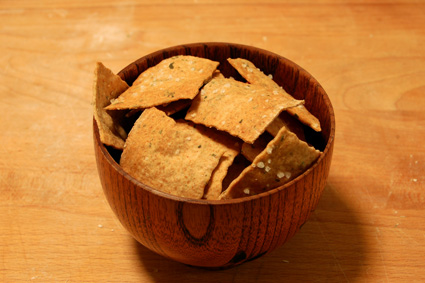Do these count as bread?

In addition to the usual breadmaking around here, I've been making crackers. Lots and lots of crackers. I'm trying to keep a jar of crackers full at (nearly) all times, because they're a real treat to snack on occasionally. The ones pictured above are whole wheat with celery, which we devoured with a vegetable soup; the next set, on the counter now, are made with rye flour and poppy seeds. Other versions have been topped with a variety of seeds - fennel, caraway, cumin, etc. - and flavored with spices like smoked paprika or sweetened with a little sugar. They're extremely easy, and flexible to boot.
I'd made less-than-special crackers every great once in a while, but mostly before I really got into baking bread. Before I started paying close attention. Besides, in Madison, I could just pick up Potter's Crackers at the Willy St. Coop. Why mess with success?
Now I no longer have that luxury. And then I spotted this article in the New York Times. More specifically, I watched the little video that accompanies it, which made the whole process look easy. Too, too easy. So I had to try again, only with a little more precision.1
Important note: crackers are easy. I've adjusted the Times recipe to make things more consistent, but a little care and attention will definitely turn out fine crackers every time.
Here's the general process, which is as close to a recipe as I follow:
- In a small bowl, mix together 200g of flour. I tend to use at least 50-75% bread flour, with something more flavorful - whole wheat, barley, rye, etc. - to top it off, but anything with some gluten in it should work on its own. I'm certain that 100% whole wheat will turn out well; all-barley and all-spelt should be okay, too. Not sure about cornmeal yet, but it might be the next experiment.
For lightly sweet crackers, try adding 30g of sugar. The dough's more difficult to work, as most sweet breads are, but they're especially crisp when done. Dusting the tops with sugar also makes for a fantastic gloss. - Include salt, ground spices, and herbs in the bowl. Poppy seeds work, too. I use about 6g of salt (a scant half tablespoon of kosher salt), and plan to use more for the top. Mix it all together well.
- Stir in 120g water (60%). Or so. It just has to be a kneadable dough. Stir to bring it together, then knead smooth-ish. There's no need to overdo it.
- For consistency's sake, I roll mine out with a pasta machine. (Number 6 on my Atlas, which is a slightly thick and chewy linguine size.) That way, I can cover two half-sheet pans2 without crowding. If you're rolling by hand, just beware of thick spots, especially around the edges.
- Brush the tops of the sheets of dough with water, the sprinkle with salt, seeds, etc. Score into whatever shapes suit - a pizza cutter or pastry wheel is handy here - and slide into the oven.
- Bake at 350°F for 20-25 minutes. I usually switch and rotate the trays after 10 and 20 minutes to bake them evenly. When they're brown and crispy, they're done. Move them to a rack to cool - which only takes a few minutes - and break them along the score marks. In an airtight container, they'll last... until they're all eaten, I guess. It doesn't take very long around here.
1In short: I'm using fewer and fewer volume measurements in baking, instead swapping them out for weight, which is far more reliable.
2The usual size in a home kitchen. Full sheet pans won't fit in my oven.


